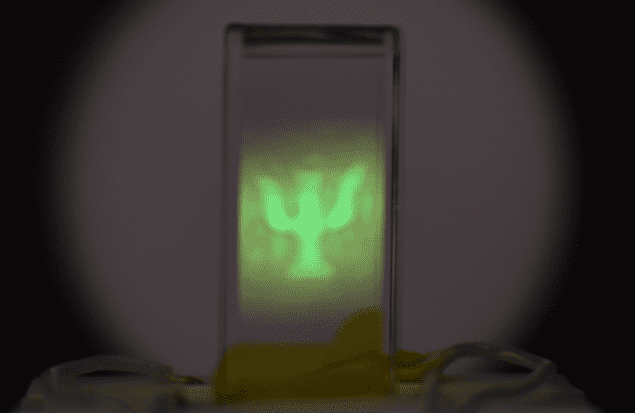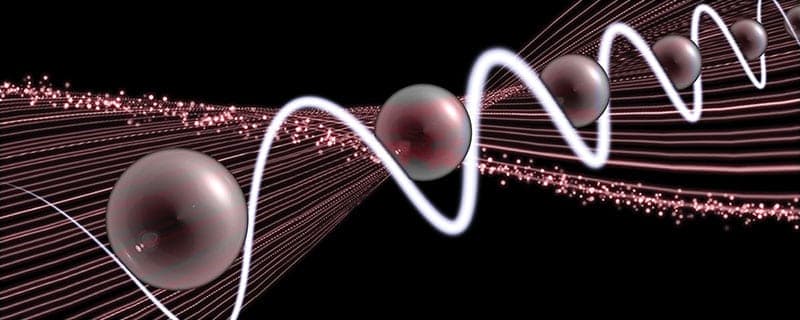
A new imaging system that uses a laser-excited, room-temperature atomic vapour to convert terahertz radiation to visible light has been created by researchers at the University of Durham in the UK. The system can acquire terahertz images rapidly and efficiently using a conventional high-speed camera and the new technique could make it easier to develop practical technologies that use terahertz radiation.
Terahertz radiation lies in the region of the electromagnetic spectrum between infrared light and microwaves. In principle, it has great promise for a wide range of applications including security screening, medical imaging and industrial quality control. However, generating and detecting electromagnetic radiation at 0.1-10 THz remains an ongoing challenge. Several competing techniques are used for different applications, but they all have disadvantages – and this lack of practical technologies is often referred to as the “terahertz gap”.
So why bother with terahertz radiation when the remaining electromagnetic spectrum is available? Durham’s Kevin Weatherill explains, “It’s a region in which many everyday materials such as paper, plastics and cloth are transparent so, as with X-rays, you can image things that are optically opaque. But being low-energy, the radiation is non-ionizing and therefore safe for biological and medical applications – though it still has a sufficiently short wavelength for reasonably high-resolution imaging.”
Slow and noisy
Several techniques have already been developed for terahertz imaging. Some systems use a single-pixel detector and build-up images by scanning a terahertz beam across the object – which is a slow process. “There are a small band of focal plane arrays or full-field sensors, which can take a 2D image in one shot,” says Weatherill, “Probably the state of the art is an array of microbolometers [thermal sensors]. Their frame rate is limited to about 30 Hz because the sensitivity is low, so you need to collect photons for a long time to see an image above the background noise.”
Weatherill and colleagues created their terahertz imaging system by filling a cell with caesium vapour and focusing three infrared lasers on it. Each laser is precisely tuned to one of three successive atomic transitions in caesium. When excited by these three lasers in succession, caesium atoms end up in a highly excited “Rydberg state”. Such an atom can then absorb a 0.55 THz photon, which puts it in a different Rydberg state that decays after about a microsecond. This decay involves the emission of a green photon, which can be then detected by a standard optical camera.
The 0.55 THz absorption is a sharp resonance, and terahertz radiation at other frequencies will not be detected. Therefore, unlike other techniques for collecting terahertz photons, the technique can reliably pick out a narrowband signal from broad spectrum thermal noise. The detection process is also about 100 times more sensitive than other techniques.
Two-colour imaging
The researchers acquired terahertz images at up to 3000 frames per second. They are now optimizing their equipment and believe that, in principle, it should be possible to collect data at frame rates up to 1 MHz. They are also keen to extend the research in other ways, such as detecting other terahertz frequencies and even two-colour terahertz imaging.
Durham’s Lucy Downes says, “I’m also very keen to try setting this up in reflection mode, so we can look for defects in the surfaces of bulk objects”.

The rise of Rydberg physics
Daniel Mittleman of Brown University in the US, says the most obvious applications of the imaging system are in the laboratory: “Things like explosions, shock wave tests, the fundamental physics of solids and fast, extreme phenomena are where you would need those kinds of frame rates, and any time the material is opaque to optics, terahertz could be an interesting alternative.”
For more commercial applications, he foresees challenges in creating practical devices. “Ultimately, it will be interesting to see how well they can package this for use outside a physics lab. If the applications are fundamental physics, that question becomes irrelevant. If they’re thinking about applications outside the laboratory, that question is relevant and I’ve no idea how to answer it.”
The research is described in a preprint on arXiv.



